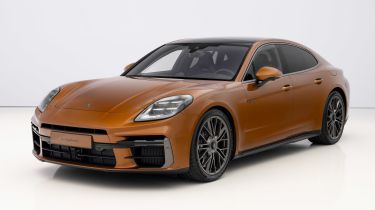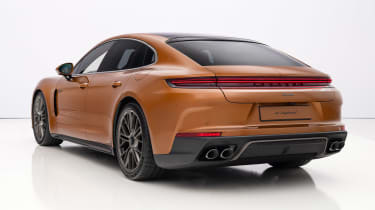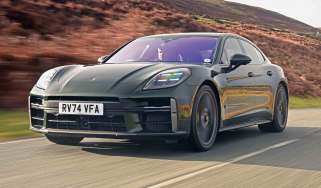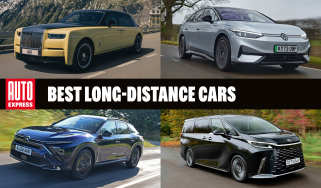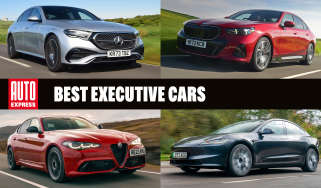New 2024 Porsche Panamera: hello Turbo E-Hybrid, goodbye Sport Turismo
Porsche’s luxury flagship has been thoroughly renewed with new style, tech and substance
The luxury car class was given a big shake up when the first generation Porsche Panamera arrived in 2009, and three generations later there’s a new iteration its maker is hoping will create as much of a stir.
Launching first with an entry-level V6 model starting at £79,500 and a high performance hybrid-assisted V8 Turbo E-Hybrid for £141,400, the new Panamera introduces a range of high-tech luxury and sporting features wrapped up in a sleek new look. Available to order now, with cars reaching customers in the first quarter of next year, it will rival top-end BMWs and Mercedes-Benzes, as well as electric rivals from Tesla and Lucid.
In typical Porsche fashion, the Panamera’s design is an evolutionary step forward from the existing model yet actually features new body panels all-round, except for the door skins. The proportions are largely the same, with only a few millimetres difference here and there thanks to reshaped bumpers, but you will notice the sharper lines and more aggressive detailing.
The nose is dominated by new angular headlights featuring the same high-end LED lighting technology as introduced on the Cayenne SUV, while around the back there’s a much cleaner light bar, joined by a wider rear glass screen. Wheel sizes sit between 19- and 21-inches, and for the first time Turbo E-Hybrid models will have the option of centre-lock wheels like those on the 911 Turbo S.
The cabin has gone through a similar treatment, sharing lots of fundamentals with the previous car, but with an even cleaner design dominated by new digital interfaces and fewer buttons. The previous analogue central rev-counter and flanking screens have been replaced with a curved fully-digital screen, joined by a central 12.3-inch touchscreen and an optional passenger display in the main dash section.
To free up space in the centre console, the drive selector is now mounted on the upper dash as in the Taycan and new Cayenne, with a combination of touch-sensitive and physical controls integrated into a small heating and ventilation control panel in between.
Fundamentally, the new Panamera rides on the same platform as the previous generation, albeit with a new MSB-w moniker. Being co-developed with Bentley, this flagship platform has all the toys you could possibly think of, and perhaps a few you didn’t. One that Porsche is particularly proud of is a new pair of suspension options that it hopes will create an even greater spread of ability between offering a luxurious ride quality and planted, dynamic handling.
The first is a twin-chamber air suspension system with Porsche’s new dual-valve damper technology. This gives engineers the ability to adjust the damper on both compression and rebound, working in conjunction with the use of simpler twin-chamber air-springs. This setup is fitted as standard on all Panamera models, but hybrid cars then gain access to a new fully active suspension option that effectively replaces the old PDCC active anti-roll system.
What’s new here are new fully active dampers that have their own individual electric motor that can completely vary the internal damper pressure. This does away with the need for anti-roll bars entirely, and combined with single chamber air suspension allows for total control of the compression, rebound and ride height. The system also uses this ability to vary ride height to raise the body for easier ingress and egress, plus counteract squat, dive and cornering movement in comfort mode.
We tried the system in a prototype and found it has an uncanny ability to keep the body level, yet totally supple a real step-change in terms of suspension technology. This setup won’t be available on non-hybrid models due to the amount of electrical energy required to operate the system, something only the hybrid’s 400V electrical system is capable of providing. Of course, this is just the tip of a technical iceberg that extends to rear-wheel steering, active aero around both the nose and rear wing – we could go on.
Porsche has only revealed two powertrain options so far, with the base rear-drive Panamera and all-wheel drive Panamera 4 utilising Porsche’s 2.9-litre twin-turbocharged V6 engine with 348bhp in both forms. Above this, however, is the new Turbo E-Hybrid that debuts an uprated hybrid system. Together with a larger 29.4kWh battery pack, the more powerful e-motor is capable of driving the car for as much as 62 miles, running through a new PDK transmission. The e-motor is also now fully integrated into the PDK housing, and features a higher torque rating at over 950Nm – the previous limit was 900Nm.
This new hybrid system works in conjunction with a heavily revised twin-turbocharged 4-litre V8 engine. All in, the Turbo E-Hybrid produces 671bhp, the same incidentally as the previous Turbo S E-hybrid, but less than the 719bhp setup in the new Cayenne. Why the variation? Porsche insists the Cayenne will not see a future Turbo S E-Hybrid model, but the Panamera will, with space left above for a new performance flagship. Performance is still impressive, mind, reaching 62mph in just 3.2 seconds and hitting a 195mph top speed.
The Turbo E-Hybrid also debuts a new aesthetic treatment that will become unique to all future Turbo models, be that the Panamera or other Porsche lines. This includes the use of a bespoke titanium colour to the wheels, window surrounds, front bumper garnish and badging, and even introduces a new monochrome Porsche shield on the front bumper. Porsche says it’s done this to bring greater differentiation to the Turbo models, something that’s also reflected in the bespoke body colour and wheel options.
Beyond the initial two models, we expect two more hybrid models to join the range in base and Panamera S, as well as a new pure V8-powered Panamera S and GTS. What won’t be reimagined, however, is the Sport Turismo body shape due to limited demand in markets outside of Europe. Porsche will continue to offer a long-wheelbase Executive model in China.
Click here for our list of the best fast family cars...
Find a car with the experts

